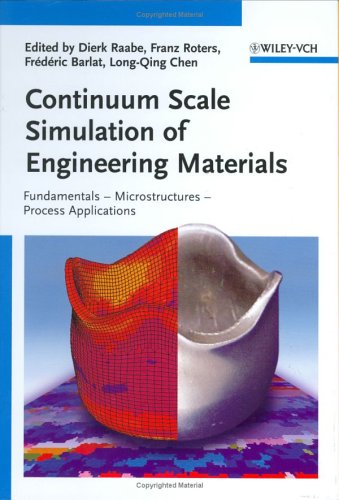

Most ebook files are in PDF format, so you can easily read them using various software such as Foxit Reader or directly on the Google Chrome browser.
Some ebook files are released by publishers in other formats such as .awz, .mobi, .epub, .fb2, etc. You may need to install specific software to read these formats on mobile/PC, such as Calibre.
Please read the tutorial at this link. https://ebooknice.com/page/post?id=faq
We offer FREE conversion to the popular formats you request; however, this may take some time. Therefore, right after payment, please email us, and we will try to provide the service as quickly as possible.
For some exceptional file formats or broken links (if any), please refrain from opening any disputes. Instead, email us first, and we will try to assist within a maximum of 6 hours.
EbookNice Team

Status:
Available4.8
31 reviews
ISBN 10: 3527307605
ISBN 13: 9783527307609
Author: Dierk Raabe, Franz Roters, Frederic Barlat, Long Qing Chen
This book fills a gap by presenting our current knowledge and understanding of continuum-based concepts behind computational methods used for microstructure and process simulation of engineering materials above the atomic scale.
The volume provides an excellent overview on the different methods, comparing the different methods in terms of their respective particular weaknesses and advantages. This trains readers to identify appropriate approaches to the new challenges that emerge every day in this exciting domain.
Divided into three main parts, the first is a basic overview covering fundamental key methods in the field of continuum scale materials simulation. The second one then goes on to look at applications of these methods to the prediction of microstructures, dealing with explicit simulation examples, while the third part discusses example applications in the field of process simulation.
By presenting a spectrum of different computational approaches to materials, the book aims to initiate the development of corresponding virtual laboratories in the industry in which these methods are exploited. As such, it addresses graduates and undergraduates, lecturers, materials scientists and engineers, physicists, biologists, chemists, mathematicians, and mechanical engineers.
Part I: Fundamentals and Basic Methods
Computer Simulation of Diffusion-Controlled Phase Transformations – A. Schneider and G. Inden
Phase-Field Modeling of Microstructure Evolution – J. W. Cahn
Cellular Automata Modeling of Microstructure Evolution – M. A. Novotny and D. Raabe
Crystal Plasticity Finite Element Modeling – F. Roters and D. Raabe
Potts Models in Materials Science – M. J. Aziz and D. Raabe
Lattice Gas Automata and Their Applications – F. Barlat and D. Raabe
Discrete Dislocation Dynamics – L.-Q. Chen and D. Raabe
Yield Surface Plasticity Models – D. Raabe and F. Roters
Artificial Neural Networks in Materials Science – D. Raabe and F. Roters
Part II: Microstructure Prediction and Modeling
10. Phase-Field Simulations of Solidification – J. W. Cahn and D. Raabe
11. Modeling of Dendritic Structures Using Cellular Automata – M. A. Novotny and D. Raabe
12. Phase-Field Simulations of Solid-State Phase Transformations – F. Roters and D. Raabe
13. Strain/Stress-Dominated Microstructure Evolution – D. Raabe and F. Roters
14. Statistical Theory of Grain Growth – D. Raabe and F. Roters
15. Curvature-Driven Grain Growth and Coarsening – D. Raabe and F. Roters
16. Deformation and Recrystallization of Particle-Containing Alloys – D. Raabe and F. Roters
17. Cellular Automaton Simulation with Variable Cell Size – D. Raabe and F. Roters
18. Vertex Grain Boundary Modeling – D. Raabe and F. Roters
19. Fluid Mechanics of Suspensions – D. Raabe and F. Roters
20. Thermal Activation in Discrete Dislocation Dynamics – L.-Q. Chen and D. Raabe
21. Statistical Dislocation Modeling – L.-Q. Chen and D. Raabe
22. Dislocation Simulations of Thin Film Plasticity – L.-Q. Chen and D. Raabe
23. Brittle to Ductile Transition in Fracture Mechanics – L.-Q. Chen and D. Raabe
24. Coarse Graining of Dislocation Dynamics – L.-Q. Chen and D. Raabe
25. Constitutive Modeling of Polymer Deformation – D. Raabe and F. Roters
26. Taylor-Type Homogenization Methods for Texture and Anisotropy – D. Raabe and F. Roters
27. Continuum Thermodynamic Modeling – D. Raabe and F. Roters
28. Self-Consistent Homogenization Methods for Texture and Anisotropy – D. Raabe and F. Roters
29. Crystal Plasticity Finite Element Simulations – F. Roters and D. Raabe
30. Texture Component Crystal Plasticity Finite Element Methods – F. Roters and D. Raabe
31. Coupling of Continuum Fields to Materials Properties Through Microstructure – D. Raabe and F. Roters
32. Micromechanical Simulations of Materials Behavior – D. Raabe and F. Roters
Part III: Process Applications
33. Modeling of Metal Forming Processes – D. Raabe and F. Roters
34. Simulation of Casting Processes – D. Raabe and F. Roters
35. Welding Process Simulation – D. Raabe and F. Roters
36. Additive Manufacturing and 3D Printing – D. Raabe and F. Roters
continuum simulation
continuum mechanics mit
continuum scale
quantitative simulation
systems engineering cost estimation
continuum scale model
Tags: Dierk Raabe, Franz Roters, Frederic Barlat, Long Qing Chen, Continuum, Simulation